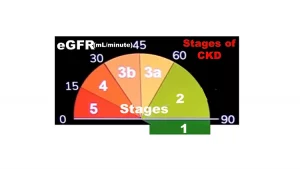Menu
Menu
It is estimated that about 10% of adult Indians have some form of kidney disease and 200,000 people get afflicted with end-stage (eGFR < 15) CKD every year. Despite this, there is very poor awareness of it among the general public, because CKD does not have apparent symptoms. This is the reason for around 50% of patients with advanced CKD are first seen by a Doctor when they are about to need Dialysis.
The most common causes of CKD are:
Insulin resistance & lifestyle diseases such as. Diabetes / Hypertension (BP): They are the leading causes of CKD and account for over 50% of individuals entering dialysis. Controlling them after the diseases are established, may not be able to halt or slow the CKD, because inflammation, endothelial dysfunction, mitochondrial injury, fibrosis, and impaired autophagy associated with Diabetes/BP contribute to the progressive nature of CKD. So, the time for action is when the eGFR drops to 90 mL/minute.
Physical Activity: Moderate physical activity is ‘pro-health’ while vigorous physical activity such as exercises done to increase muscle mass/burn calories without appropriate nutrition can put a strain on the kidneys.
CKD due Glomerulonephritis, Genetic diseases, Drug-induced kidney diseases, Recurrent kidney infection: These are medical conditions and need nephrologist’s intervention as lifestyle changes are not sufficient and have a limited contribution.

Stage 1, 2, and 3a: These stages can be reversed by having full Recommended Dietary Allowances (RDA) of Protein and Potassium from whole foods i.e., 0.83 to 1 gm/kg of body weight of PDCAAS adjusted protein and 3600 mg of Potassium. (Gross protein in 100 gms of Atta is 10.57 gms while PDCAAS adjusted protein is only 4.4 gms.) Having full RDA in these stages preserves the muscle, which is essential because protein quantity needs to be restricted in the unfortunate event of CKD progressing to the latter stages.
Stage 3b and 4: Keep the PRAL (potential renal acid load) low by eating a balanced diet and restricting protein to 0.6 to 0.8 gms/kg.
Potential renal acid load (PRAL) of some foods (for 100 g of edible portion).
| Foods | PRAL (mEq/100 g) |
|---|---|
| Fruits and fruit juices | −3 |
| Banana | −8.2 |
| Vegetables | −2.8 |
| Carrots | −6.4 |
| Fruits and oils | 0 |
| Milk and whey-based products | +1.0 |
| Brown Rice | +2.2 |
| Bread | +3.5 |
| Noodles,spaghetti | +6.7 |
| Fish | +7.9 |
| Cheese (protein<15g/100g) | +8.0 |
| Meat and meat products | +9.5 |
Stage 5 and unsuccessful efforts in reversing earlier Stages: Consult the nephrologist in the unfortunate event of CKD progressing to Stage 5 or if the efforts to reverse earlier stages, through lifestyle, changes are unsuccessful.
| Foods | PRAL (mEq/100 g) |
|---|---|
| Fruits and fruit juices | −3 |
| Banana | −8.2 |
| Vegetables | −2.8 |
| Carrots | −6.4 |
| Fruits and oils | 0 |
| Milk and whey-based products | +1.0 |
| Brown Rice | +2.2 |
| Bread | +3.5 |
| Noodles,spaghetti | +6.7 |
| Fish | +7.9 |
| Cheese (protein<15g/100g) | +8.0 |
| Meat and meat products | +9.5 |
QHUB, SASI ICON, JUBILEE HILLS, ROAD NO 36 & 37, HYDERABAD,TELANGANA, 500033
9.00 am - 9.00 pm

We have been the most trusted Health care Nutrition for 25 years. We’re proud of our rich history for nutritionists services.